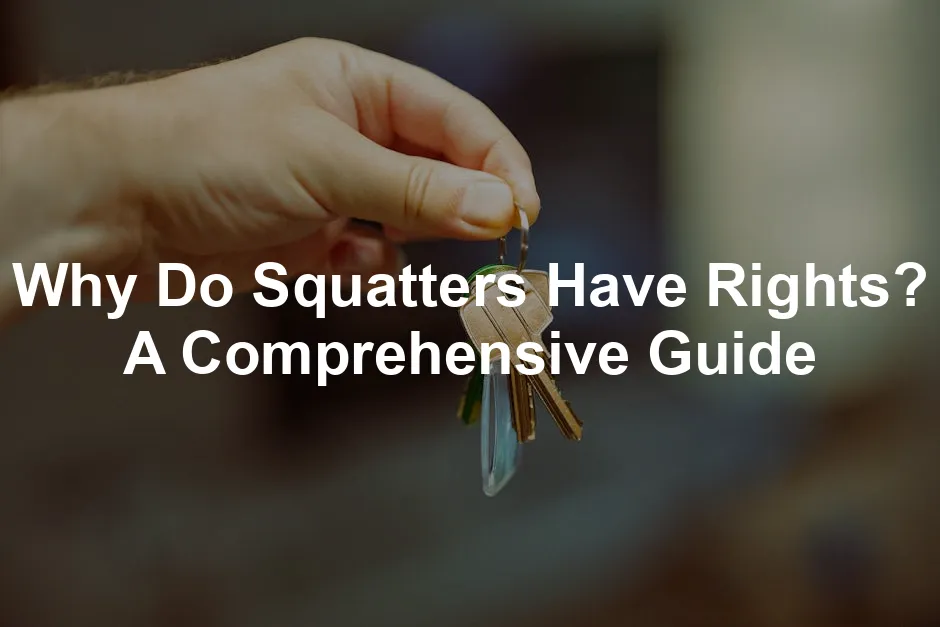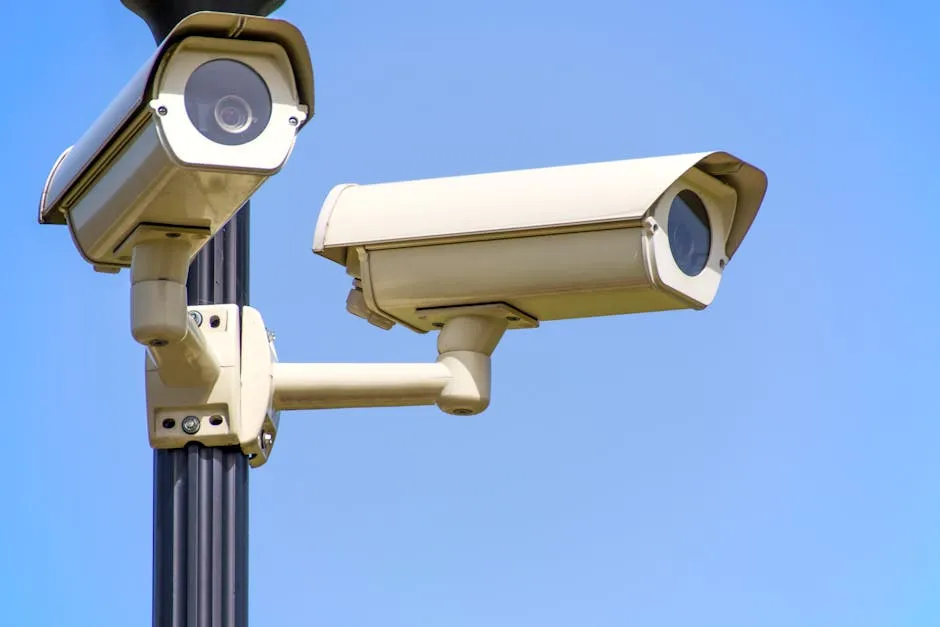
Why Do Squatters Have Rights? A Comprehensive Guide
Introduction
In the world of real estate, few issues are as contentious and perplexing as squatter rights. Imagine finding a stranger comfortably settled in your rental property, sipping coffee as if they own the place. Frustrating, right? Yet, this scenario is the reality for many landlords and homeowners who discover that squatters have certain legal protections. This article explores the fascinating and complex world of squatters’ rights, exploring why they exist, the laws that underpin them, and what both property owners and squatters need to know. We’ll tackle everything from the historical context to modern implications, arming you with the knowledge to navigate this often murky legal terrain.
Understanding squatter rights starts with recognizing that they stem from a historical need to address issues of land use and ownership. The origins trace back to medieval property laws, designed to encourage individuals to utilize land rather than leave it abandoned. Fast forward to today, and these laws have evolved into what we now know as adverse possession. This legal doctrine allows squatters to claim ownership of a property after occupying it for a specific period without the owner’s permission.
The laws governing squatters’ rights are not uniform; they vary significantly across different states. In some places, a squatter may gain rights after just a few years, while in others, it could take decades. This patchwork of regulations often leaves property owners feeling blindsided.
This article will illuminate the reasons behind squatter rights, examining their legal foundations and implications. Understanding these rights is crucial for landlords who want to protect their investments and for squatters who may find themselves navigating a precarious legal situation. So, whether you’re a property owner or a curious tenant, strap in for a rollercoaster ride through the world of squatting, property rights, and the law!

What is a Squatter?
A squatter is someone who occupies a property without any legal right or permission from the owner. Unlike traditional tenants, who have a lease or rental agreement, squatters have no formal relationship with the property owner. They often take residence in abandoned, foreclosed, or unoccupied buildings, making themselves at home without consent.
The intent of squatters differs significantly from that of trespassers. A squatter aims to establish residency and may even seek to claim ownership over time. In contrast, trespassers typically have no intention of staying long-term. They enter a property unlawfully, often for a brief period, and without any desire to maintain a presence.
Legally, squatters can achieve a degree of protection through adverse possession laws. These laws allow individuals to claim ownership of a property after residing there for a specified time without the owner’s permission. However, to gain these rights, squatters must meet specific criteria, such as continuous occupancy, open and notorious use of the property, and sometimes even payment of property taxes.
This complex legal status creates a challenging scenario for property owners. It blurs the lines between rights and ownership, complicating the eviction process. Property owners can’t simply kick squatters out; they must follow a legal eviction process similar to that for regular tenants. This legal framework aims to balance property rights with the need for housing, especially in areas facing housing shortages.
Understanding the implications of squatting is crucial for both property owners and those who might find themselves in squatting situations. Recognizing the differences between squatters and trespassers, as well as the legal protections afforded to squatters, can help navigate this tricky landscape. Whether you’re a landlord or just curious, knowing the ins and outs of squatters’ rights is essential in today’s housing climate.

Why Do Squatters Have Rights?
Historical Context
Squatters’ rights have roots in historical laws aimed at promoting land use. In medieval times, property laws encouraged individuals to occupy and improve neglected lands, preventing abandonment. Over time, these laws evolved into what we know today as adverse possession. This legal doctrine allows squatters to claim ownership of a property after residing there for a designated period, typically ranging from five to twenty years, depending on the state.
The purpose of these laws is multifaceted. They address societal issues like urban development and housing shortages. As cities grow, vacant properties often become targets for squatters, who find affordable living options in abandoned spaces. The laws aim to prevent property owners from neglecting their responsibilities while also protecting people seeking shelter. By ensuring due process before eviction, these laws discourage landlords from taking matters into their own hands, which can lead to violence or vigilante justice.

Speaking of protecting your property, if you’re a landlord or homeowner, you might want to consider investing in a Home Security Camera System. It can be a game-changer in deterring unauthorized occupants and keeping an eye on your property when you’re not around.
Legal Framework
At the heart of squatter rights lies the doctrine of adverse possession. This legal principle allows a squatter to gain ownership of a property if they meet specific requirements. These typically include open and notorious possession, exclusive use of the property, continuous occupation for the statutory period, and sometimes payment of property taxes.
Different states enforce adverse possession laws uniquely. For instance, in California, a squatter must occupy a property for at least five years, while New York requires ten years. Some states may have additional requirements, such as demonstrating improvements to the property. Understanding these variations is crucial for property owners and squatters alike.
Legal protections for squatters can provide them with a buffer against immediate eviction. In many states, landlords must serve an eviction notice and follow legal procedures before removing squatters. This process parallels that of evicting a tenant, further blurring the lines between legitimate occupancy and unlawful squatting.
In summary, squatters have rights due to historical legal frameworks designed to prevent property neglect and address housing needs. By understanding the origins and legal basis of these rights, both property owners and squatters can better navigate the complex landscape of property law.

What Rights Do Squatters Have?
Legal Protections
Squatters are not just people who overstayed their welcome. They often have certain legal rights that can make a landlord’s life a bit more complicated. In many jurisdictions, squatters gain legal protections under adverse possession laws. These laws allow a squatter to claim rights to a property if they meet specific criteria.
First, the squatter must occupy the property openly and notoriously. This means they cannot hide their presence; their occupation must be obvious. Second, they must demonstrate exclusive possession. If a squatter shares the property with the owner or other individuals, their claim may be weakened.
As for the duration of occupancy, different states have varying requirements. Some states require as little as five years of continuous occupation, while others may demand up to thirty years. Additionally, some jurisdictions necessitate the payment of property taxes during the squatter’s stay, which can further solidify their claim.
This legal framework is crucial for property owners to understand. It underscores that squatters cannot simply be kicked out without following proper legal procedures. The law recognizes their rights to some extent, making it essential for landlords to act swiftly and legally when dealing with squatters.
For landlords looking to navigate these complex waters, consider picking up “The Landlord’s Legal Guide: How to Avoid Legal Problems”. It’s a must-read for anyone wanting to stay on the right side of the law while managing their properties.

Eviction Process
Now, let’s talk about eviction—an essential process for property owners. However, it’s not as simple as just calling the police and asking them to remove the squatter. In most states, squatters cannot be forcibly removed without due process. This means landlords must go through the legal eviction process.
Initially, landlords must serve an eviction notice, much like they would for a tenant who has failed to pay rent. This notice informs the squatter that they must vacate the property. If the squatter refuses to leave, the landlord must then file an unlawful detainer action in court. This legal proceeding can take time, often involving court appearances and potential delays.
During this process, it’s vital for landlords to keep thorough records. Documenting the squatter’s presence, any communication attempts, and the eviction notice can be useful in court. The eviction process may feel lengthy and frustrating for property owners, particularly if they are dealing with a squatter who knows the legal system well.

Claims of Ownership
So, how does a squatter actually claim ownership of a property? The magic phrase here is “adverse possession.” To succeed in such claims, squatters must meet specific criteria. First, their possession must be open and notorious, meaning it’s visible and not secretive. They must also possess the property exclusively, maintaining control without sharing it with the owner.
Continuous occupation is another crucial factor. Most states require squatters to live on the property for a defined period—often many years. This requirement emphasizes the importance of consistent residency. For instance, if a squatter moves in, stays for a few months, and then leaves, they likely won’t meet the criteria for adverse possession.
Finally, some jurisdictions require the payment of property taxes during the period of occupation. This stipulation can complicate matters for property owners. If squatters successfully meet all the criteria for adverse possession, they may then file a lawsuit to formalize their claim. This legal process can lead to a court declaring them the rightful owners, leaving property owners scratching their heads in disbelief.
Understanding these rights and legal complexities is essential for property owners. By being informed about squatters’ rights, landlords can better prepare themselves to navigate the challenges that come with unauthorized occupancy of their properties.

Understanding Squatting vs. Trespassing
Definitions
While squatting and trespassing might seem similar, they are fundamentally different. A squatter is someone who occupies property without the owner’s permission but intends to establish residency. They often seek to claim rights to the property over time. Trespassing, on the other hand, involves entering someone’s property without permission, typically for a brief period. Trespassers usually have no intention of staying long-term.

Legal Consequences
The legal ramifications for squatting and trespassing vary significantly. Trespassers can be removed quickly by law enforcement, as their actions are often considered a criminal offense. Squatters, however, enjoy certain protections under adverse possession laws. This means that even though their presence is unauthorized, they cannot be removed without going through a legal process.
Examples
Consider a scenario in which a person breaks into a vacant property to take shelter for a night—this is a classic example of trespassing. The police can remove them immediately. Conversely, if someone moves into that same vacant property and begins paying utilities, making improvements, and treating it as their home, they might be considered a squatter. Over time, they could potentially claim rights to the property, leading to a complex legal situation for the original owner.
Understanding these distinctions is vital for both property owners and residents. With different rights and legal protections at play, knowing the difference between squatting and trespassing can help navigate challenging situations.

How to Evict a Squatter: Legal Steps
Initial Actions
Call Law Enforcement: The first step when dealing with squatters is to contact local law enforcement. Police can help assess the situation and determine whether the individual is a squatter or a trespasser. It’s important to understand that, depending on your state, law enforcement may not remove squatters immediately. However, having an official report can bolster your case in later eviction proceedings. They can also provide guidance on the proper steps to take next, and their presence may help to diffuse any potential confrontations.
Serve Eviction Notices: After notifying the police, it’s crucial to initiate the eviction process formally. Serving an eviction notice is a legal requirement in many jurisdictions. This notice informs the squatter that they must vacate the property. Make sure to follow your state’s specific requirements for the eviction notice. Failure to do so can lead to delays in the eviction process. It’s also wise to keep a copy of this notice for your records, as it may be needed in court later.
For landlords, having the right forms on hand can streamline the eviction process. I recommend checking out Legal Forms for Real Estate Transactions. Having the right documentation is key to making the eviction process smoother.

Legal Process
Unlawful Detainer Action: If the squatter refuses to leave after receiving the eviction notice, you must file an unlawful detainer action. This legal document initiates the formal eviction process and is typically filed in the local courthouse. The court will review your case, and if approved, a hearing will be scheduled. Be sure to provide all necessary documentation, such as the eviction notice and any evidence of the squatter’s occupancy. This step can vary significantly by state, so consulting a legal professional can be helpful to navigate specific requirements.
Court Process: During the court hearing, both you and the squatter will have the opportunity to present evidence. Be prepared to explain your case clearly and provide documentation, such as photographs of the property, any communication with the squatter, and the eviction notice. If the judge rules in your favor, they will issue an order for the squatter to vacate the property. This court order allows law enforcement to assist in the removal if necessary. Remember, the court process can take time, so patience is key.

Handling Belongings
Legal Guidelines: After the eviction process is complete, you may need to deal with any belongings left behind by the squatter. It’s essential to follow your state’s legal guidelines when handling these items. In many cases, you cannot simply dispose of the belongings. Instead, you may need to store them for a certain period and provide the squatter with notice about how they can reclaim their items. Failure to comply with these regulations can lead to legal complications, so it’s crucial to handle the situation thoughtfully and within the law. Always document your actions in case of future disputes.

Prevention Strategies for Property Owners
Regular Inspections: One of the best ways to prevent squatting is to conduct regular inspections of your property. This practice helps you stay aware of any unauthorized occupants. By keeping a close eye on your property, you can identify potential squatting situations early. Regular visits also show that the property is being actively managed, which can deter squatters looking for easy targets.
Security Measures: Taking proactive security measures can safeguard your property from squatters. Start by securing all entrances with locks and deadbolts. Installing security cameras and motion-activated lights can also deter unauthorized access. Consider putting up “No Trespassing” signs to clearly communicate that your property is off-limits. Each of these measures makes it less appealing for squatters to attempt to occupy your property.
Community Engagement: Involving your neighbors can create a supportive network that watches over your property. Encourage them to report any suspicious activity or signs of unauthorized occupancy. A vigilant community can act as a deterrent for squatters and provide additional eyes on your property when you are away. Building relationships with your neighbors fosters a sense of shared responsibility and can lead to quicker action if a squatting situation arises.
By understanding the legal steps for eviction and implementing prevention strategies, property owners can effectively manage and mitigate the risks associated with squatters.

Conclusion
In conclusion, understanding squatters’ rights is essential for both property owners and those who may find themselves in a squatting situation. These rights can complicate property ownership and the eviction process, leaving many landlords perplexed. However, knowledge is power! By being informed and prepared, landlords can significantly mitigate risks associated with squatters.
Taking proactive measures is key. Regular property inspections, securing entrances, and maintaining open communication with neighbors can help prevent unauthorized occupancy. It’s also vital to familiarize yourself with local laws regarding squatting and eviction processes. This knowledge can empower owners to act swiftly and legally, ensuring they protect their investments while respecting the rights of individuals facing housing challenges.
As housing issues continue to evolve in our society, so too will the discussions surrounding squatting and property rights. The ongoing dialogue will likely influence future legislation. Thus, staying updated on changes in the legal landscape is crucial. Landlords who navigate these complexities with agility will not only safeguard their property but also contribute to a healthier, more understanding community.
In this ever-changing environment, understanding squatter rights offers valuable insights into property ownership. So, whether you’re a seasoned landlord or new to the game, equipping yourself with knowledge about squatters’ rights can help you stay ahead of potential challenges.

FAQs
What are squatters’ rights?
Squatters’ rights, also known as adverse possession, refer to the legal rights gained by individuals who occupy a property without the owner’s permission for a specified period. This can lead to legitimate claims of ownership if certain conditions are met.
How long must a squatter occupy a property to gain rights?
The time frame varies by state. For instance, some states require as little as five years, while others may demand up to 30 years of continuous occupancy before rights are established.
Can squatters be treated as tenants?
Yes, in many legal frameworks, squatters are treated similarly to tenants in that they cannot be removed without due process. Landlords must follow legal eviction procedures, similar to those required for terminating a lease with a tenant.
What should a property owner do if they find a squatter?
Property owners should first contact local law enforcement to document the situation. Following that, they should serve an eviction notice and commence the unlawful detainer process if the squatter refuses to leave.
Are there any recent changes to squatters’ rights laws?
Yes, several states have recently enacted changes, aiming to clarify and streamline the eviction process for property owners. For example, some states have made it easier for landlords to remove squatters through expedited procedures or new legislative measures that redefine tenant rights.
Please let us know what you think about our content by leaving a comment down below!
Thank you for reading till here 🙂
All images from Pexels




